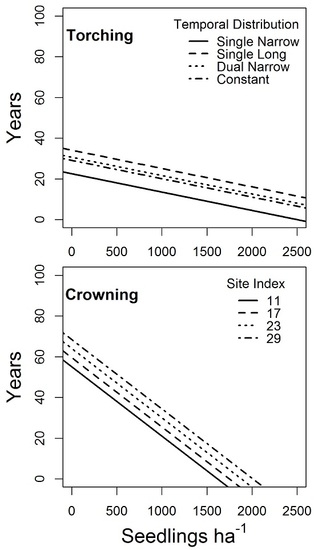Ponderosa Pine Forest Restoration Treatment Longevity: Implications of Regeneration on Fire Hazard
Abstract
:1. Introduction
2. Materials and Methods
2.1. Study Region
2.2. Stand Inventory Design
2.3. Model and Simulation Parameterization
2.4. Fire Hazard Modeling
2.5. Analysis
3. Results
4. Discussion
5. Conclusions
Acknowledgments
Author Contributions
Conflicts of Interest
References
- Bentz, B.J.; Régnière, J.; Fettig, C.J.; Hansen, E.M.; Hayes, J.L.; Hicke, J.A.; Kelsey, R.G.; Negrón, J.F.; Seybold, S.J. Climate change and bark beetles of the western United States and Canada: Direct and indirect effects. BioScience 2010, 60, 602–613. [Google Scholar] [CrossRef]
- Kemp, K.B.; Blades, J.J.; Klos, Z.P.; Hall, T.E.; Force, J.; Morgan, P.; Tinkham, W.T. Managing for climate change on federal lands of the western United States: Perceived usefulness of climate science, effectiveness of adaptation strategies, and barriers to implementation. Econ. Soc. 2015, 20, 17. [Google Scholar] [CrossRef]
- Westerling, A.L.; Turner, M.G.; Smithwick, E.A.H.; Romme, W.H.; Ryan, M.G. Continued warming could transform Greater Yellowstone fire regimes by mid-21st century. Proc. Nat. Acad. Sci. USA 2011, 108, 13165–13170. [Google Scholar] [CrossRef] [PubMed]
- Smith, A.M.S.; Kolden, C.A.; Tinkham, W.T.; Talhelm, A.; Marshall, J.D.; Hudak, A.T.; Boschetti, L.; Falkowski, M.J.; Greenberg, J.A.; Anderson, J.W.; et al. Remote sensing the vulnerability of vegetation in natural terrestrial ecosystems. Remote Sens. Environ. 2014, 154, 322–337. [Google Scholar] [CrossRef]
- Covington, W.W. Helping western forests heal: The prognosis is poor for US forest ecosystems. Nature 2000, 408, 135–136. [Google Scholar] [CrossRef] [PubMed]
- Allen, S.R.; Savage, M.; Falk, D.A.; Suckling, K.F.; Swetnam, T.W.; Shulke, T.; Stacey, P.B.; Morgan, P.; Hoffman, M.; Klingel, J.T. Ecological restoration of southwestern ponderosa pine ecosystems: A broad perspective. Econ. Appl. 2002, 12, 1418–1433. [Google Scholar] [CrossRef]
- Cooper, C.F. Changes in vegetation, structure, and growth of southwestern pine forests since white settlement. Econ. Monogr. 1960, 30, 129–164. [Google Scholar] [CrossRef]
- Covington, W.W.; Moore, M.M. Southwestern ponderosa forest structure: Changes since Euro-American settlement. J. For. 1994, 92, 39–47. [Google Scholar]
- Clement, J.; Brown, P.M. Front Range Roundtable, Collaborative Forest Landscape Restoration Project 2011: Ecological, Social, and Economic Monitoring Plan; Colorado Forest Restoration Institute: Fort Collins, CO, USA, 2011; p. 57. [Google Scholar]
- Dickinson, Y. Landscape restoration of a forest with a historically mixed-severity fire regime: What was the historical landscape pattern of forest and openings? For. Econ. Manag. 2014, 331, 264–271. [Google Scholar] [CrossRef]
- Franklin, J.F.; Mitchell, R.J.; Palik, B.J. Natural Disturbance and Stand Development Principles for Ecological Forestry; United States Department of Agriculture/Forest Service Rocky Mountain Research Station: Fort Collins, CO, USA, 2007.
- Larson, A.J.; Churchill, D.C. Tree spatial patterns in fire-frequent forests of western North America, including mechanisms of pattern formation and implications for designing fuel reduction and restoration treatments. For. Econ. Manag. 2012, 267, 74–92. [Google Scholar] [CrossRef]
- Reynolds, R.T.; Sánchez Meador, A.J.; Youtz, J.A.; Nicolet, T.; Matonis, M.S.; Jackson, P.L.; DeLorenzo, D.G.; Graves, A.D. Restoring Composition and Structure in Southwestern Frequent-Fire Forests: A Science-Based Framework for Improving Ecosystem Resiliency; United States Department of Agriculture/Forest Service Rocky Mountain Research Station: Fort Collins, CO, USA, 2013.
- Aubry, K.B.; Amaranthus, M.P.; Halpern, C.B.; White, J.D.; Woodard, B.L.; Peterson, C.E.; Lagoudakis, C.A.; Horton, A.J. Evaluating the effects of varying levels and patterns of green-tree retention: Experimental design of the DEMO study. Northwest Sci. 1999, 73, 12–26. [Google Scholar]
- Carey, A.B. Biocomplexity and restoration of biodiversity in temperate coniferous forests: Inducing spatial heterogeneity with variable-density thinning. Forestry 2003, 76, 127–136. [Google Scholar] [CrossRef]
- Stanturf, J.A.; Palik, B.J.; Dumroese, R.K. Contemporary forest restoration: A review emphasizing function. For. Econ. Manag. 2014, 331, 292–323. [Google Scholar] [CrossRef]
- Agee, J.K.; Skinner, C.N. Basic principles of forest fuel reduction treatments. For. Econ. Manag. 2005, 211, 83–96. [Google Scholar] [CrossRef]
- Fulé, P.Z.; Crouse, J.E.; Roccaforte, J.A.; Kalies, E.L. Do thinning and/or burning treatments in wester USA ponderosa and Jeffrey pine-dominated forests help restore natural fire behavior? For. Econ. Manag. 2012, 269, 68–81. [Google Scholar] [CrossRef]
- Hudak, A.T.; Rickert, I.; Morgan, P.; Strand, E.; Lewis, S.A.; Robichaud, P.; Hoffman, C.; Holden, Z.A. Review of Fuel Treatment Effectiveness in Forests and Rangelands and a Case Study from the 2007 Megafires in Central Idaho USA; USDA: Washington, DC, USA, 2007.
- Omi, P.N.; Martinson, E.J. Effectiveness of thinning and prescribed fire in reducing wildfire severity. In Proceedings of the Sierra Nevada Science Symposium: Science for Management and Conversation, Davis, CA, USA, 10 March 2015; Murphy, D.D., Stine, P.A., Eds.; pp. 87–92.
- Stephens, S.L.; Moghaddas, J.J.; Ediminster, C.; Fiedler, C.E.; Hasse, S.; Harrington, M.; Keeley, J.E.; McIver, J.D.; Metlen, K.; Skinner, C.N.; et al. Fire treatment effects on vegetation structure, fuels, and potential fire severity in western US forests. Ecol. Appl. 2009, 19, 305–320. [Google Scholar] [CrossRef] [PubMed]
- Battaglia, M.A.; Smith, F.W.; Shepperd, W.D. Can prescribed fire be used to maintain fuel treatment effectiveness over time in Black Hills ponderosa pine forests? For. Econ. Manag. 2008, 256, 2029–2038. [Google Scholar] [CrossRef]
- Fulé, P.Z.; Laughlin, D.C.; Covington, W.W. Pine-oak forest dynamics five years after ecological restoration treatments, Arizona, USA. For. Econ. Manag. 2005, 218, 129–145. [Google Scholar] [CrossRef]
- Fulé, P.Z.; Roccaforte, J.P.; Covington, W.W. Posttreatment tree mortality after forest ecological restoration, Arizona, United States. Environ. Manag. 2007, 40, 623–634. [Google Scholar] [CrossRef] [PubMed]
- Stephens, S.L.; Collins, B.M.; Roller, G. Fuel treatment longevity in a Sierra Nevada mixed conifer forest. For. Econ. Manag. 2012, 285, 204–212. [Google Scholar] [CrossRef]
- Johnson, M.C.; Kennedy, M.C.; Peterson, D.L. Simulating fuel treatment effects in dry forests of the western United States: Testing the principles of a fire-safe forest. Can. J. For. Res. 2011, 41, 1018–1030. [Google Scholar] [CrossRef]
- Mast, J.N.; Fulé, P.Z.; Moore, M.M.; Covington, W.W.; Waltz, A.E.M. Restoration of presettlement age structure of an Arizona ponderosa pine forest. Ecol. Appl. 1999, 9, 228–239. [Google Scholar] [CrossRef]
- Boyden, S.; Binkley, D.; Shepperd, W. Spatial and temporal patterns in structure, regeneration, and mortality of an old-growth ponderosa pine forest in the Colorado Front Range. For. Econ. Manag. 2005, 219, 43–55. [Google Scholar] [CrossRef]
- Zald, H.S.J.; Gray, A.N.; North, M.; Kern, R.A. Initial tree regeneration responses to fire and thinning treatments in a Sierra Nevada mixed-conifer forest, USA. For. Econ. Manag. 2008, 256, 168–179. [Google Scholar] [CrossRef]
- Miina, J.; Eerikäinen, K.; Hasenauer, H. Modeling forest regeneration. In Sustainable Forest Management: Growth Models for Europe; Hasenauer, H., Ed.; Springer: Berlin, Germany, 2006; pp. 93–109. [Google Scholar]
- Shepperd, W.D.; Edminster, C.B.; Mata, S.A. Long-term seedfall, establishment, survival, and growth of natural and planted ponderosa pine in the Colorado Front Range. West. J. Appl. For. 2006, 21, 19–26. [Google Scholar]
- Flathers, K.N.; Kolb, T.E.; Bradford, J.B.; Waring, K.M.; Moser, K.W. Long-term thinning alters ponderosa pine reproduction in northern Arizona. For. Econ. Manag. 2016, 374, 154–165. [Google Scholar] [CrossRef]
- Puhlick, J.J.; Laughlin, D.C.; Moore, M.M. Factors influencing ponderosa pine regeneration in the southwestern USA. For. Econ. Manag. 2012, 264, 10–19. [Google Scholar] [CrossRef]
- Brown, P.M.; Wu, R. Climate and disturbance forcing of episodic tree recruitment in a Southwestern ponderosa pine landscape. Ecology 2005, 86, 3030–3038. [Google Scholar] [CrossRef]
- Battaglia, M.A.; Smith, F.W.; Shepperd, W.D. Predicting mortality of ponderosa pine regeneration after prescribed fire in the Black Hills, South Dakota, USA. Int. J. Wildl. Fire 2009, 18, 176–190. [Google Scholar] [CrossRef]
- Mason, G.J.; Baker, T.T.; Cram, D.S.; Boren, J.C.; Fernald, A.G.; VanLeeuwen, D.M. Mechanical fuel treatment effects on fuel loads and indices of crown fire potential in a south central New Mexico dry mixed conifer forest. For. Econ. Manag. 2007, 251, 195–204. [Google Scholar] [CrossRef]
- Stephens, S.L. Evaluation of the effects of silvicultural and fuels treatments on potential fire behavior in Sierra Nevada mixed conifer forests. For. Econ. Manag. 1998, 105, 21–35. [Google Scholar] [CrossRef]
- Scott, J.H.; Reinhardt, E.D. Assessing Crown Fire Potential by Linking Models of Surface and Crown Fire Behavior; United States Department of Agriculture: Fort Collins, CO, USA, 2001.
- Rothermel, R.C. A Mathematical Model for Predicting Fire Spread in Wildland Fuels; United States Department of Agriculture: Washington, DC, USA, 1972.
- Rothermel, R.C. Predicting Behavior and Size of Crown Fires in the Northern Rocky Mountains; United States Department of Agriculture: Washington, DC, USA, 1991.
- Van Wagner, C.E. Conditions for the start and spread of crown fire. Can. J. For. Res. 1977, 7, 23–34. [Google Scholar] [CrossRef]
- Cruz, M.G.; Alexander, M.E.; Wakimoto, R.H. Definition of a fire behavior model evaluation protocol: A case study application to crown fire behavior models. In Proceedings of the Fire, Fuel Treatments, and Ecological Restoration Conference, Fort Collins, CO, USA, 16–18 April 2002; Omi, P.N., Joyce, L.N., Eds.; USDA Forest Service Proceeding: Washington, DC, USA, 2003. [Google Scholar]
- Cruz, M.G.; Alexander, M.E. Assessing crown fire potential in coniferous forests of western North America: A critique of current approaches and recent simulation studies. Int. J. Wildl. Fire 2010, 19, 377–398. [Google Scholar] [CrossRef]
- Cruz, M.G.; Alexander, M.E.; Wakimoto, R.H. Modeling the likelihood of crown fire occurrence in conifer forest stands. For. Sci. 2004, 50, 640–658. [Google Scholar]
- Comer, P.J.; Reid, M.S.; Rondeau, R.J.; Black, A.; Stevens, J.; Bell, J.; Menefee, M.; Cogan, D. A Working Classification of Terrestrial Ecological Systems in the Northern Colorado Plateau: Analysis of Their Relation to the National Vegetation Classification System and Application to Mapping; NatureServe, National Park Service: Arlington, VA, USA, 2002; p. 23. [Google Scholar]
- Tuhy, J.; Comer, P.; Dorfman, D.; Lammert, M.; Neely, B.; Whitham, L.; Silbert, S.; Bell, G.; Humke, J.; Baker, B.; et al. An Ecoregional Assessment of the Colorado Plateau; The Nature Conservancy, Moab Project Office: Arlington, VA, USA, 2002; p. 112. [Google Scholar]
- Carmean, W.H. Forest site quality evaluation in the United States. Adv. Agron. 1975, 27, 209–269. [Google Scholar]
- Ziegler, J. Impacts of Treatments on Forest Structure and Fire Behavior in Dry Western Forests. Master’s Thesis, Colorado State University, Fort Collins, CO, USA, May 2014. [Google Scholar]
- Dixon, G.E. Essential FVS: A User’s Guide to the Forest Vegetation Simulator; United States Department of Agriculture/Forest Service Management Service Center: Fort Collins, CO, USA, 2002; p. 204.
- Crookston, N.L.; Dixon, G.E. The forest vegetation simulator: A review of its structure, content, and applications. Comput. Electron. Agric. 2005, 49, 60–80. [Google Scholar] [CrossRef]
- Reinhardt, E.; Crookston, N.L. The Fire and Fuels Extension to the Forest Vegetation Simulator; Department of Agriculture, Forest Service, Rocky Mountain Research Station: Fort Collins, CO, USA, 2003.
- Bailey, J.D.; Covington, W.W. Evaluating ponderosa pine regeneration rates following ecological restoration treatments in northern Arizona, USA. For. Econ. Manag. 2002, 155, 271–278. [Google Scholar] [CrossRef]
- Ferguson, D.E.; Crookston, N.L. User’s Guide to Version 2 of the Regeneration Establishment Model: Part of the Prognosis Model; Department of Agriculture, Forest Service, Rocky Mountain Research Station: Fort Collins, CO, USA, 1991.
- Alexander, M.E.; Cruz, M.G.; Lopes, A.M.G. CFIS: A software tool for simulating crown fire initiation and spread. In Proceedings of the V International Conference on Forest Fire Research, Coimbra, Portugal, 27–30 November 2006.
- Reinhardt, E.; Scott, J.; Gray, K.; Keane, R. Estimating canopy fuel characteristics in five conifer stands in the western United States using tree and stand measurements. Can. J. For. Res. 2006, 36, 2803–2814. [Google Scholar] [CrossRef]
- Scott, J.H.; Reinhardt, E.D. Stereo Photo Guide for Estimating Canopy Fuel Characteristics in Conifer Stands; Department of Agriculture, Forest Service, Rocky Mountain Research Station: Fort Collins, CO, USA, 2005.
- Keyser, C.E.; Dixon, G.E. Central Rockies (CR) Variant Overview—Forest Vegetation Simulator; Department of Agriculture, Forest Service, Forest Management Service Center: Fort Collins, CO, USA, 2008; p. 70. [Google Scholar]
- Tobin, J. Estimation of relationships for limited dependent variables. Econometrica 1958, 26, 24–36. [Google Scholar] [CrossRef]
- McDonald, J.F.; Moffitt, R.A. The uses of Tobit Analysis. Rev. Econ. Stat. 1980, 62, 318–321. [Google Scholar] [CrossRef]
- Roccaforte, J.P.; Huffman, D.W.; Fulé, P.Z.; Covington, W.W.; Chancellor, W.W.; Stoddard, M.T.; Crouse, J.E. Forest Structure and fuels dynamics following ponderosa pine restoration treatments, White Mountains, Arizona, USA. For. Econ. Manag. 2015, 337, 174–185. [Google Scholar] [CrossRef]
- Thomas, T.L.; Agee, J.K. Prescribed fire effects on mixed conifer forest structure at Crater Lake, Oregon. Can. J. For. Res. 1986, 16, 1082–1087. [Google Scholar] [CrossRef]
- Cruz, M.G.; Alexander, M.E.; Wakimoto, R.H. Development and testing of models for predicting crown fire rate of spread in conifer forest stands. Can. J. For. Res. 2005, 35, 1626–1639. [Google Scholar] [CrossRef]
- Johnson, E.A. Fire and Vegetation Dynamics: Studies from the North American Boreal Forest; Cambridge University Press: Cambridge, UK, 1996. [Google Scholar]
- Laessle, A.M. Spacing and competition in natural stands of sand pine. Ecology 1965, 46, 65–72. [Google Scholar] [CrossRef]
- Weiskittel, A.R.; Maguire, D.A.; Monserud, R.A. Response of branch growth and mortality to silvicultural treatments in coastal Douglas-fir plantations: Implications for predicting tree growth. For. Econ. Manag. 2007, 251, 182–194. [Google Scholar] [CrossRef]
- Garber, S.M.; Monserud, R.A.; Maguire, D.A. Crown recession patterns in three conifer species of the northern Rocky Mountains. For. Sci. 2008, 54, 633–646. [Google Scholar]
- Hoffman, C.; Morgan, P.; Mell, W.; Parsons, R.; Strand, E.K.; Cook, S. Numerical simulation of crown fire hazard immediately after bark beetle-caused mortality in Lodgepole pine forests. For. Sci. 2012, 58, 178–188. [Google Scholar] [CrossRef]
- Linn, R.R.; Sieg, C.H.; Hoffman, C.M.; Winterkamp, J.L.; McMillin, J.D. Modeling wind fields and fire propagation following bark beetle outbreaks in spatially-heterogeneous pinyon-juniper woodland fuel complexes. Agric. For. Met. 2013, 173, 139–153. [Google Scholar] [CrossRef]
- Hoffman, C.M.; Canfield, J.; Linn, R.R.; Mell, W.; Sieg, C.H.; Pimont, F.; Ziegler, J. Evaluating crown fire rate of spread predictions from physics-based models. Fire Technol. 2016, 52, 221–237. [Google Scholar] [CrossRef]
- Rebain, S.A. The Fire and Fuels Extension to the Forest Vegetation Simulator; United States Department of Agriculture/Forest Service Rocky Mountain Research Station, Forest Management Service Center: Fort Collins, CO, USA, 2009.
- North, M. Managing Sierra Nevada Forest; United States Department of Agriculture/Forest Service Rocky Mountain Research Station, Forest Management Service Center: Fort Collins, CO, USA, 2012.
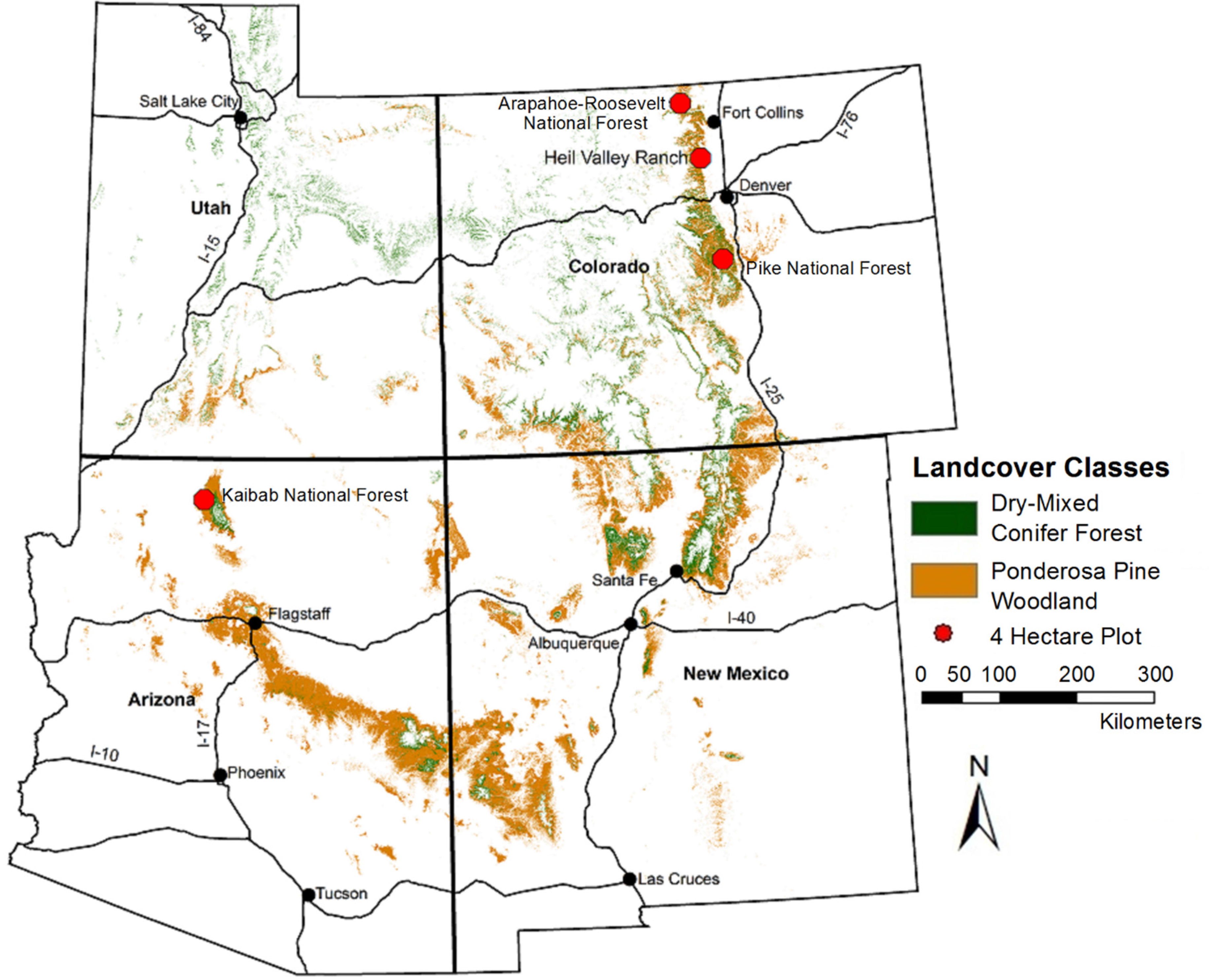
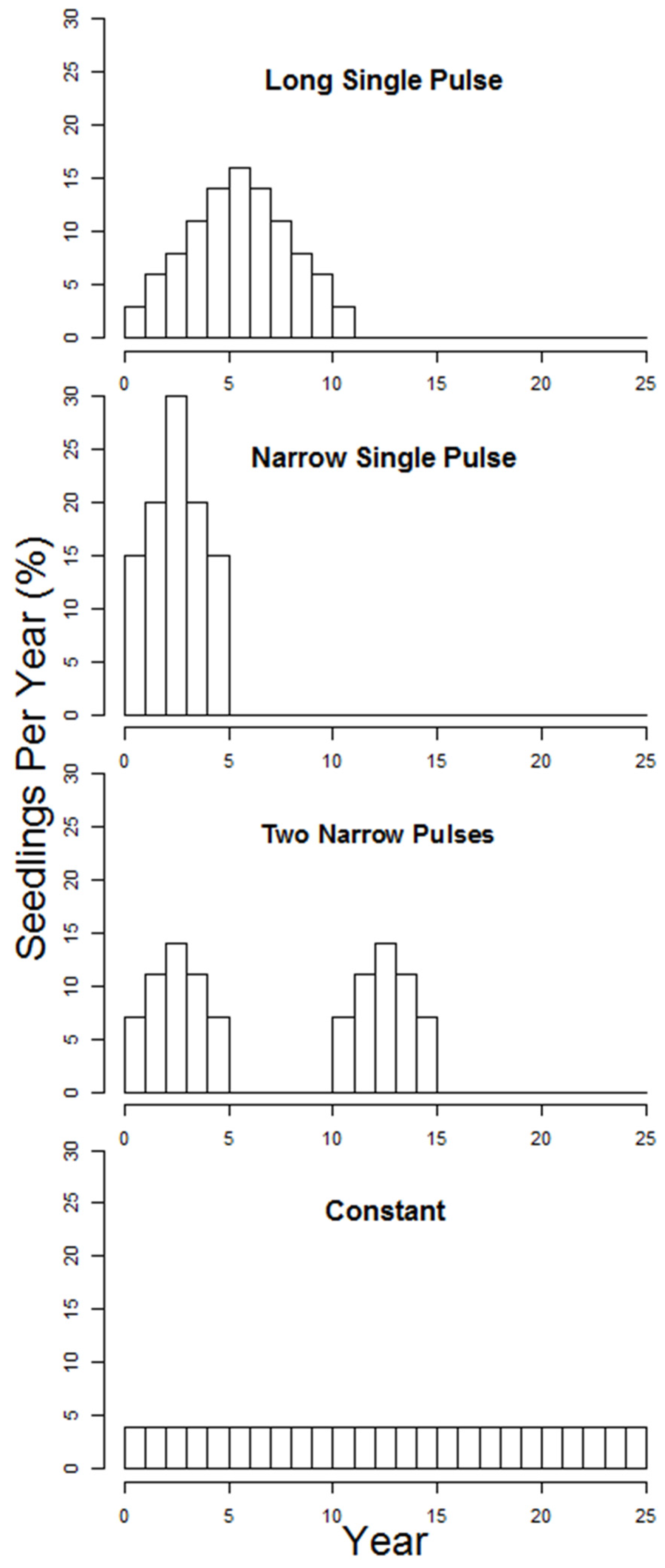

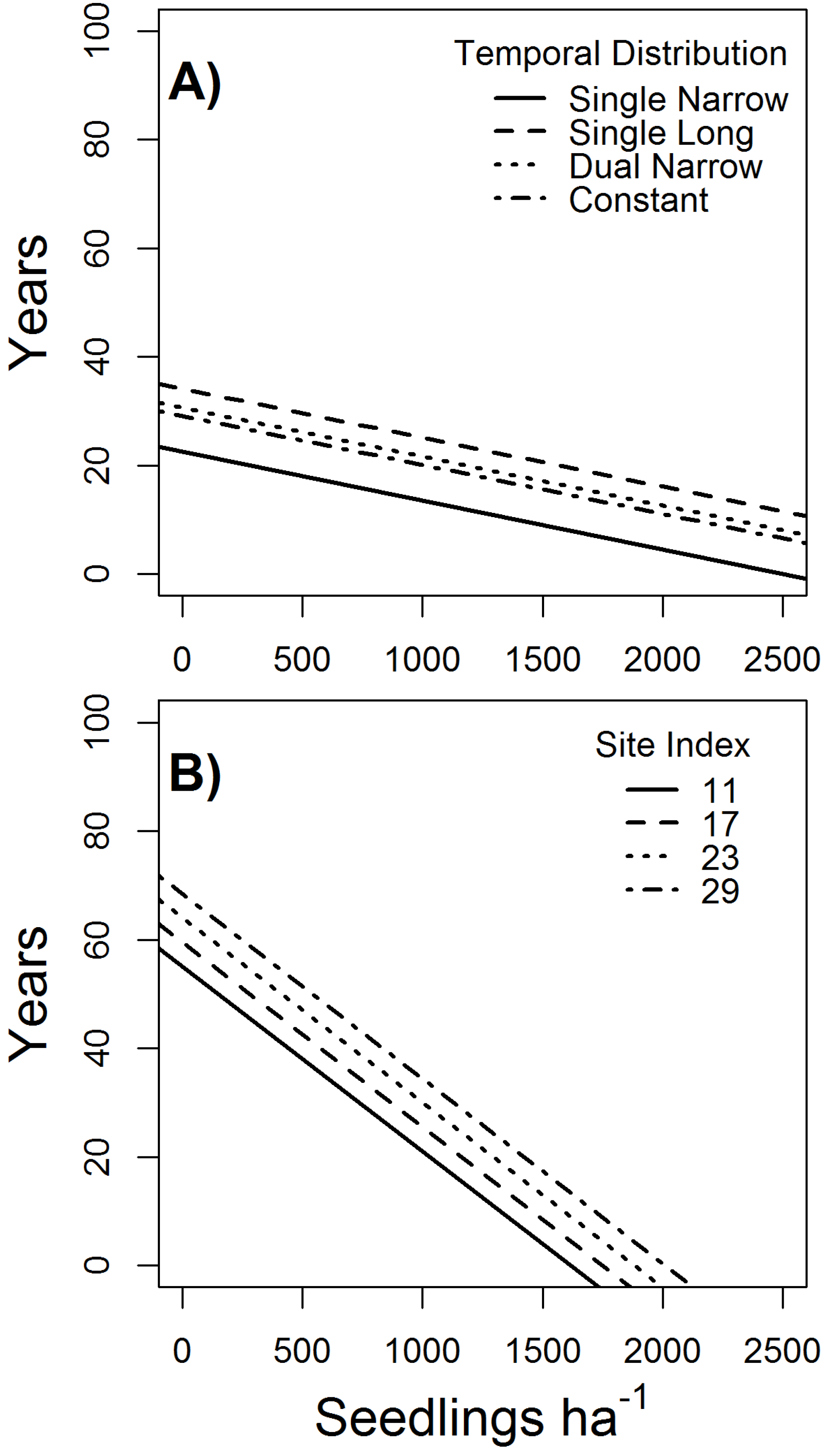
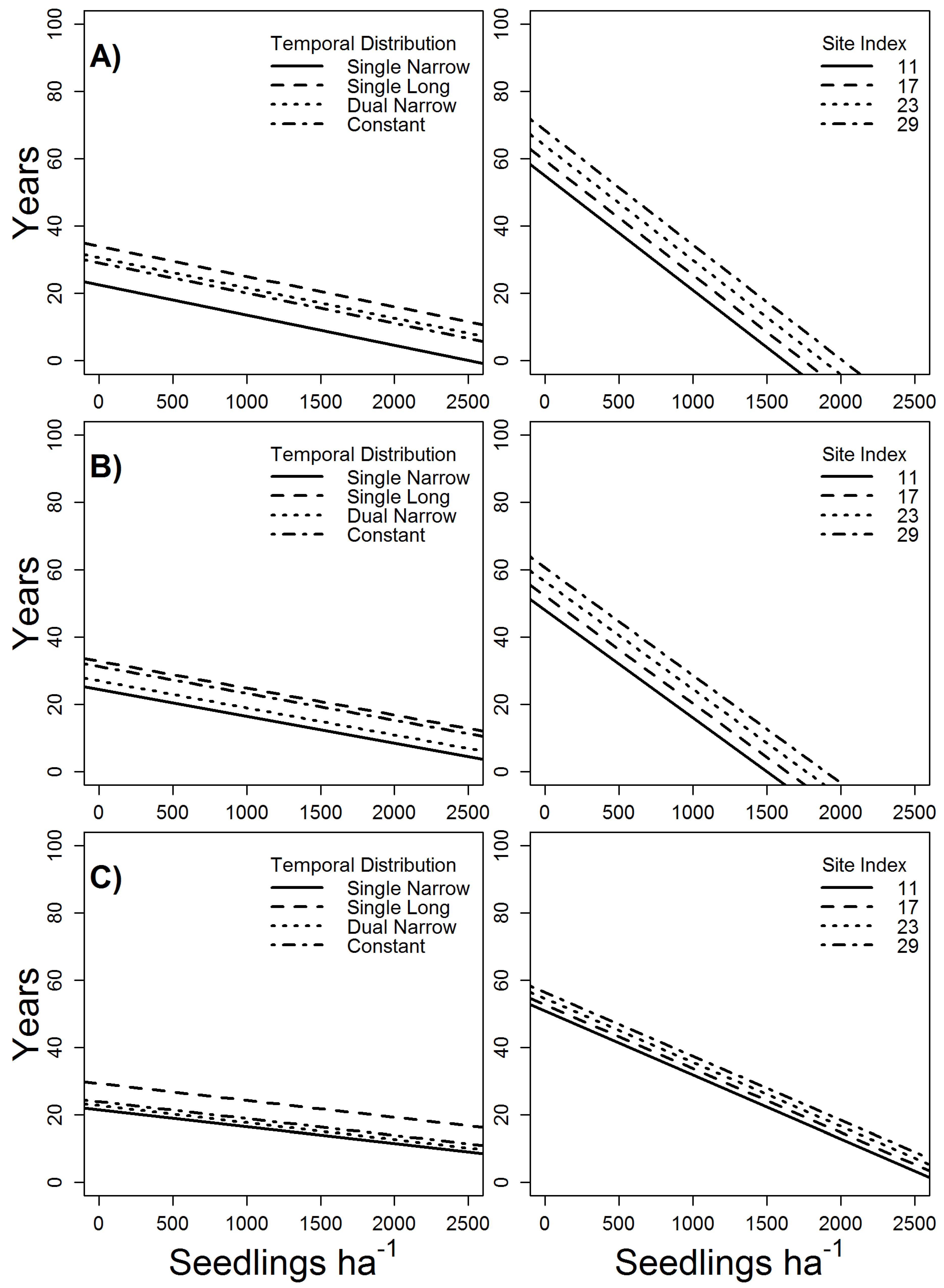
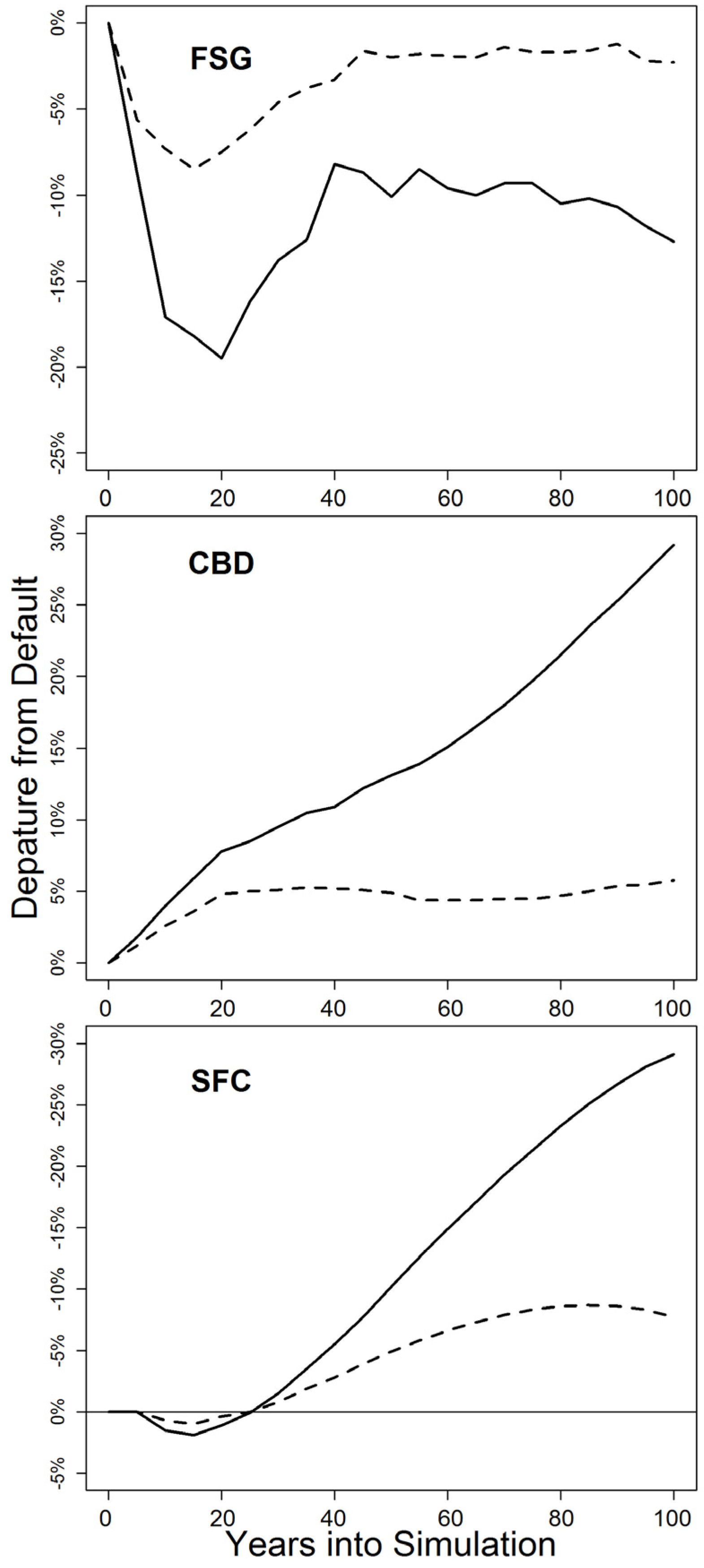
| Site | Thinning Status | Site Index § (m) | Tree ha−1 | Basal Area (m2 ha−1) | QMD † (cm) | CBH † (m) | Species Proportion * |
|---|---|---|---|---|---|---|---|
| Boulder County Open Space | Pre | 11 | 417 | 18.9 | 23.9 | 3.0 | PIPO †† (99%) |
| Post | 296 | 14.3 | 24.9 | 3.4 | PIPO (99%) | ||
| Roosevelt National Forest | Pre | 17 | 410 | 14.0 | 20.8 | 2.4 | PIPO (95%) PSME †† (4%) |
| Post | 148 | 9.0 | 27.9 | 4.6 | PIPO (97%) PSME (3%) | ||
| Pike National Forest | Pre | 23 | 711 | 29.0 | 22.9 | 3.0 | PIPO (86%) PSME (13%) |
| Post | 245 | 15.5 | 26.9 | 5.2 | PIPO (86%) PSME (11%) | ||
| Kaibab National Forest | Pre | 29 | 410 | 25.5 | 28.2 | 4.0 | PIPO (100%) |
| Post | 190 | 19.8 | 36.3 | 8.2 | PIPO (100%) |
| Site | Thinning Status | FVS-FFE Derived Parameters | CFIS Fire Hazard Level | |||
|---|---|---|---|---|---|---|
| CBD † (kg m−3) | FSG † (m) | SFC † (kg m−2) | Torching (km h−1) | Crowning (km h−1) | ||
| Boulder County Open Space | Pre | 0.084 | 1.5 | 0.744 | 7.5 | 13.2 |
| Post | 0.060 | 2.9 | 0.741 | 12.0 | 20.7 | |
| Roosevelt National Forest | Pre | 0.051 | 1.5 | 0.236 | 7.5 | 14.1 |
| Post | 0.034 | 3.6 | 0.230 | 11.9 | 43.1 | |
| Pike National Forest | Pre | 0.044 | 0.9 | 0.815 | 6.2 | 25.3 |
| Post | 0.025 | 3.7 | 0.805 | 10.7 | 67.3 | |
| Kaibab National Forest | Pre | 0.045 | 2.4 | 0.676 | 9.2 | 30.1 |
| Post | 0.028 | 6.7 | 0.671 | 18.0 | 57.7 | |
| Dependent Variable Torching | |||||
| β | SE * | p-Value | LB * | UB * | |
| β0—Intercept | 22.558 | 5.764 | <0.001 | 11.262 | 33.855 |
| β1—Site Index | 0.053 | 0.068 | 0.432 | −0.080 | 0.186 |
| β2—Seedlings | −0.009 | 0.002 | <0.001 | −0.013 | −0.005 |
| β3—Distribution | |||||
| Single Narrow | 0 | - | - | - | - |
| Single Long | 11.563 | 4.286 | <0.010 | 3.162 | 19.963 |
| Dual Narrow | 8.125 | 4.291 | <0.100 | −0.284 | 16.534 |
| Constant | 6.562 | 4.294 | 0.432 | −1.853 | 14.977 |
| Dependent Variable Crowning | |||||
| β | SE * | p-Value | LB * | UB * | |
| β0—Intercept | 46.764 | 17.627 | <0.010 | 12.215 | 81.313 |
| β1—Site Index | 0.748 | 0.214 | <0.001 | 0.329 | 1.167 |
| β2—Seedlings | −0.034 | 0.006 | <0.001 | −0.046 | −0.022 |
| β3—Distribution | |||||
| Single Narrow | 0 | - | - | - | - |
| Single Long | 9.874 | 13.244 | 0.456 | −16.084 | 35.832 |
| Dual Narrow | 17.086 | 13.326 | 0.200 | −9.031 | 43.204 |
| Constant | 13.572 | 13.282 | 0.307 | −12.460 | 39.603 |
| Dependent Variable Torching | |||||||
| CRNMULT | 1.0 | 0.5 | 0.0 | ||||
| β (p-Value) | LB–UB * | β (p-Value) | LB–UB * | β (p-Value) | LB–UB * | ||
| β0—Intercept | 22.558 (<0.001) | 11.262–33.855 | 24.420 (<0.001) | 14.368–34.472 | 21.497 (<0.001) | 14.298–28.695 | |
| β1—Site Index | 0.053 (0.432) | −0.080–0.186 | −0.011 (0.856) | −0.129–0.107 | −0.083 (<0.100) | −0.167–0.002 | |
| β2—Seedlings | −0.009 (<0.001) | −0.013–(−0.005) | −0.008 (<0.001) | −0.011–(−0.004) | −0.003 (<0.010) | −0.005–(−0.001) | |
| β3—Distribution | |||||||
| Single Narrow | 0 | 0 | 0 | ||||
| Single Long | 11.563 (<0.010) | 3.162 –19.963 | 8.438 (<0.050) | 0.969–15.906 | 7.813 (<0.010) | 2.472–13.153 | |
| Dual Narrow | 8.125 (<0.100) | −0.284–16.534 | 2.500 (0.513) | −4.992–9.992 | 1.250 (0.647) | −4.100–6.600 | |
| Constant | 6.562 (0.432) | −1.853–14.977 | 6.875 (<0.100) | −0.597–14.347 | 2.500 (0.359) | −2.846–7.846 | |
| Dependent Variable Crowning | |||||||
| CRNMULT | 1.0 | 0.5 | 0.0 | ||||
| β (p-Value) | LB–UB * | β (p-Value) | LB–UB * | β (p-Value) | LB–UB * | ||
| β0—Intercept | 46.764 (<0.010) | 12.215–81.313 | 43.835 (<0.010) | 14.014 –77.655 | 49.074 (<0.001) | 26.228–71.919 | |
| β1—Site Index | 0.748 (<0.001) | 0.329–1.167 | 0.702 (<0.001) | 0.317–1.086 | 0.309 (<0.050) | 0.040–0.578 | |
| β2—Seedlings | −0.034 (<0.001) | −0.046–(−0.022) | −0.032 (<0.001) | −0.042–(−0.021) | −0.019 (<0.001) | −0.027–(−0.012) | |
| β3—Distribution | |||||||
| Single Narrow | 0 | 0 | 0 | ||||
| Single Long | 9.874 (0.456) | −16.084–35.832 | 10.784 (0.377) | −13.140–34.708 | 3.004 (0.729) | −13.983–19.992 | |
| Dual Narrow | 17.086 (0.200) | −9.031–43.204 | 11.479 (0.347) | −12.457–35.414 | 7.211 (0.406) | −9.780–24.202 | |
| Constant | 13.572 (0.307) | −12.460–39.603 | 11.985 (0.327) | −11.959–35.929 | 4.629 (0.593) | −12.358–21.617 | |
© 2016 by the authors; licensee MDPI, Basel, Switzerland. This article is an open access article distributed under the terms and conditions of the Creative Commons Attribution (CC-BY) license (http://creativecommons.org/licenses/by/4.0/).
Share and Cite
Tinkham, W.T.; Hoffman, C.M.; Ex, S.A.; Battaglia, M.A.; Saralecos, J.D. Ponderosa Pine Forest Restoration Treatment Longevity: Implications of Regeneration on Fire Hazard. Forests 2016, 7, 137. https://doi.org/10.3390/f7070137
Tinkham WT, Hoffman CM, Ex SA, Battaglia MA, Saralecos JD. Ponderosa Pine Forest Restoration Treatment Longevity: Implications of Regeneration on Fire Hazard. Forests. 2016; 7(7):137. https://doi.org/10.3390/f7070137
Chicago/Turabian StyleTinkham, Wade T., Chad M. Hoffman, Seth A. Ex, Michael A. Battaglia, and Jarred D. Saralecos. 2016. "Ponderosa Pine Forest Restoration Treatment Longevity: Implications of Regeneration on Fire Hazard" Forests 7, no. 7: 137. https://doi.org/10.3390/f7070137
APA StyleTinkham, W. T., Hoffman, C. M., Ex, S. A., Battaglia, M. A., & Saralecos, J. D. (2016). Ponderosa Pine Forest Restoration Treatment Longevity: Implications of Regeneration on Fire Hazard. Forests, 7(7), 137. https://doi.org/10.3390/f7070137







